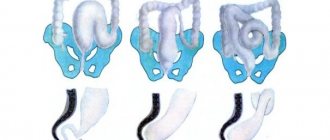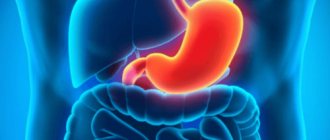Gluten intolerance is a chronic digestive disorder characterized by damage to the small intestine when exposed to gluten.
Celiac disease develops in children who carry the HLA-DQ protein. Gluten intolerance affects 1% of the population in Europe and North America. In Ukraine, celiac disease occurs in 0.5% of the population. Most children are asymptomatic or have minimal symptoms. Some have atypical forms with obvious signs of the disease.
The only treatment with proven effectiveness is a strict gluten-free diet, so if the diet is followed, the disease does not make itself felt. In this article we will examine the following questions: what gluten is, what foods contain it, how celiac disease manifests itself, methods for diagnosing and treating the disease. It should be remembered: celiac disease is not a death sentence, but a way of life.
What is celiac disease?
Celiac disease is an autoimmune disorder that occurs when the immune system reacts to eating foods containing gluten, a protein found in barley, rye and wheat.
This immune response causes inflammation and damage to the small intestine, ultimately leading to nutritional deficiencies and poor health. Celiac disease in children can occur any time after wheat or other gluten-containing foods are introduced into the diet. As a rule, the first noticeable signs appear after 6 - 9 months.
It is not known why some children become ill early in life and others only after years of exposure. There is wide variation in the severity of symptoms. For many children, symptoms begin within minutes or hours of eating gluten and last only a few hours. In other situations, symptoms last for several days or even weeks.
Many children have mild signs and are easy to miss. For example, excessive gas, abdominal pain or constipation. Other children have more severe symptoms that will lead to an earlier diagnosis. The most noticeable signs include the baby's inability to fully develop, weight loss and vomiting.
The only cure for celiac disease is a lifelong gluten-free diet. Eliminating gluten from the diet is a highly effective treatment that allows the small intestine to heal, resulting in normal nutrient absorption. Fortunately, both children and teenagers usually respond well to treatment with this diet. Many children feel significantly better after two weeks on the diet and achieve normal height, weight and mental development.
Celiac disease in children - a new look at an old problem
Celiac disease is a chronic polysyndromic disease that is characterized by nonspecific damage to the mucous membrane of the small intestine by gluten, disrupting food absorption in the damaged area, and the disappearance of the damage with the complete elimination of wheat gliadin and similar fractions of rye, barley, and oats from food. Celiac disease, which was considered an extremely rare disease in Russia, is actually quite common: on average, 1 case per 100–200 people [1,2]. We repeat that neither “celiac disease” nor “secondary celiac disease” exists. The clinical picture of celiac disease is very diverse, which allows many authors to call it the “Great Mime”. The “classic” form manifests itself clinically 4–8 weeks after the introduction of gluten-containing products into the diet. Often the disease begins later, sometimes even at school age, under the influence of factors that contribute to the development of genetic defects (intestinal infections or other acute diseases, stressful situations, etc.). In young children, weight loss develops, acquired skills are lost, bowel movements become frequent and profuse, and the abdomen swells. Children become aggressive and capricious. In severe forms, the diagnosis is usually made on time and, accordingly, a diet is prescribed. With clinically unexpressed forms of the disease, as well as the inattention of parents and doctors, several years often pass before the correct diagnosis is established. During this time, severe metabolic disorders occur in the child’s body, which are sometimes irreversible, especially when autoimmune diseases associated with celiac disease are added. Based on an examination of 306 children with a verified diagnosis of celiac disease and comparing them with the control group, a clinical analysis of various forms of the disease was made. All symptoms were observed in children for a long time (at least 3 months). One of the cardinal symptoms of the further course of celiac disease is the pathological nature of the stool, noted in 216 (83.4%) children (p <0.05), which becomes profuse, fetid, light (gray, gray-yellow, gray-brown or “multi-colored”). "), loose, foamy or clayey, putty-like, difficult to wash off from the child or from the container, making it difficult to start defecation, sometimes greasy (shiny). Parents who characterize their child’s stool say that the stool resembles “eggplant caviar”, “puffs like rising dough”, “lathers over the child”; “the child is sitting on his chair on the potty, it’s so plentiful” or the stool is “squeezed out of the diapers from all sides.” Undigested food particles are often noted, and in extreme cases, the stool resembles vomit or looks like unchanged porridge eaten by the child several hours before. Some children have formed, but very plentiful, stools. Some children have stools that are characterized by alternating mushy, liquid, and formed stools with varying durations. It should be noted that 16.6% of those examined had absolutely normal, formed stools, which significantly complicates the diagnosis of the disease, which in most cases is based on stool disturbances as the main symptom of celiac disease [3]. The stool frequency of children with celiac disease ranged from 0 to 20 times a day, of which the stool frequency of 1–2 times a day, accepted as the norm, was observed in 92 (36.2%) children; constipation, in which stool was less frequent, than once every 72 hours - in 26 (10.2%) patients, stool 3-4 times a day in 94 (37%) children and 5 or more times - in 42 (16.5%) patients (p< 0.05). The number of bowel movements is one of the significant symptoms observed in celiac disease: heavy stool was observed in 164 (66.4%) children and very heavy stool in 18 (7.3%), for a total of 73.7% (p <0.05 ). In the works of the 70–80s of the 20th century, authors dealing with the problem of celiac disease in children characterize the child’s swollen abdomen, similar to a “spider belly” due to a sharp swelling of the intestinal loops and pseudoascites. In order to objectify the assessment of abdominal circumference in children with celiac disease, we used the Andronescu index, modified by I.N. Grigovich et al. (1990), which represents the percentage ratio of abdominal circumference to the child’s height. In healthy children under the age of 1 year it is 53%, up to 3 years – 42–45%, up to 14 years – 41–42%. Moderate bloating - up to 50% according to the Andronescu index - was determined in 97 (33.7%) of the examined children, severe bloating - in 117 (40.7%) children (data not statistically significant). The genesis of pain syndrome in celiac disease consists of stretching of the intestinal loops due to bloating with gases and overflow of feces, enlarged liver, hypomotor dysfunction of the gallbladder and bile ducts, swelling of the pancreas, and other reasons. Damage to the pancreas is often functional in nature. Abdominal pain as the main symptom of celiac disease was observed in 186 (72.9%) children, of which 152 (59.6%) (p <0.001) had pain in the mesogastric region, which is a characteristic manifestation of the disease. The increase in pain occurred 3–5 hours after eating, or before defecation. One of the significant symptoms of damage to the gastrointestinal tract in celiac disease is recurrent vomiting, observed in 119 (48%) children (p <0.05). Appetite disturbances observed in 150 (60.5%) patients (p <0.05) included a decrease and increase in appetite, with most children characterized by alternating periods of lack of appetite and its sharp increase. Damage to the skeletal system, one of the causes of which is a violation of Ca-P metabolism, is one of the manifestations of celiac disease, and not its complication. Quite often, bone pain is interpreted by pediatricians as “growing pains,” but in some patients the intensity of the pain requires the administration of analgesic drugs. 54% of children with bone pain are under the supervision of an orthopedist, traumatologist, rheumatologist, and hematologist. In total, bone pain was observed in 131 (52.8%) children (p <0.05). Joint pain, observed in 81 (32.9%) patients (p <0.05), was characterized by damage to large joints (mainly knees and ankles) without signs of arthritis. In addition, 95 children had caries (37.6%, p<0.05), 50 patients had scoliosis (20.2%, p<0.05), 15 children had fractures of long bones (6.2 %, p<0.01), 90 had osteoporosis, determined by X-ray examination (37.2%, p<0.001) A decrease in the child’s body weight, a sensitive parameter that responds to diseases and malnutrition, is a significant symptom in celiac disease and reflects the severity of nutritional disorders. A decrease in body weight was observed in 127 (52.7%) children, of which a decrease of 3d or more was observed in 24 patients (9.2%) (the differences are statistically insignificant). Reduced growth in children with celiac disease also reflects a lack of nutrition, but, in addition, in the genesis of its reduction there are mechanisms of somatotropic, thyroid-stimulating insufficiency and a decrease in the level of thyroid hormones due to autoimmune thyroiditis. Decreased growth was detected in 66 (27.9%) children (p <0.001). The causes of damage to the nervous system in celiac disease is the development of encephalopathy, the genesis of which can be divided into 2 types: toxic and hypoenergetic [4]. In the first case, an accumulation of under-oxidized decomposition products occurs, which manifests itself in the manifest form of celiac disease. Psychoneurologically expressed syndrome of aggression, irritability, possibly worsening abdominal pain. In the second type, energy substrates are depleted and they cannot be utilized due to an enzymatic block. Clinically it resembles the first type, but there are specific features: a significant decrease in muscle tone, dystonia, vegetative-vascular insufficiency, persistent headaches that cannot be treated, sleep disturbances, as well as depression and autism. Irritability was noted in 159 (64.4%) children (p<0.01), aggression – in 98 (39.5%) patients (p<0.001). In addition, headaches were observed in 110 children (44.7%, p<0.001), poor falling asleep, combined with restless sleep in 105 patients (43%, p<0.001), and a tendency to depression in 25 patients (10.2% , p<0.001). Episyndrome was observed in 17 (7%) patients. Due to a violation of the barrier function of the mucous membrane of the small intestine, undigested proteins with antigenic properties penetrate into the internal environment, which causes or aggravates existing allergic diseases. The commonality of the mechanisms of immunological reactions can lead to the same type of clinical manifestations from the gastrointestinal tract in celiac disease and food allergies, which complicates diagnosis. This is especially true for young children with food allergies to milk. In addition to these manifestations, patients had general manifestations of vitamin-mineral and protein deficiency: frequent acute respiratory viral infections (163 children - 66.8%), increased fatigue (131 patients - 43.5%), muscle cramps up to tetany (34 children - 14% ), increased bleeding with the presence of ecchymosis (42 children - 17.4%) and nosebleeds (47 patients - 19.3%), widespread skin itching (92 children - 37.8%), recurrent stomatitis (70 patients - 29, 2%), persistent furunculosis (45 children - 18.6%), prolonged recurrent temperature conditions (50 patients - 20.7%), impaired twilight vision, hair loss up to alopecia, dystrophic changes and brittleness of nails, follicular hyperkeratosis, vitiligo , cheilitis, and others, observed in 3–6% of cases. Thus, there is not a single symptom that would occur in 100% of patients with celiac disease, which leads to many diagnostic errors and observation of the child by 5-8 specialists at the same time. Children are seen by many specialists, including gastroenterologists (abdominal pain, stool disorders, etc.), allergists (atopic dermatitis, recurrent urticaria, bronchial asthma, etc.), dermatologists (dermatitis herpetiformis, atopic dermatitis, vitiligo, etc.) , neurologists (headache, dizziness, astheno-neurotic syndrome, etc.), orthopedists (pain in the limbs, scoliosis, etc.), endocrinologists (growth retardation, sexual development, autoimmune lesions of the thyroid gland, etc.), rheumatologists (arthralgia, arthritis, prolonged febrile conditions, etc.), hematologists (bleeding, thrombocytopathy, etc.). Children are repeatedly admitted to infectious diseases hospitals with complaints of loose stools and vomiting, often accompanied by an increase in temperature, since a breakdown occurs when an acute respiratory viral infection is added. According to foreign researchers, with a long course of unrecognized celiac disease, the risk of tumors of the gastrointestinal tract and other localizations and autoimmune diseases associated with celiac disease increases - type 1 diabetes mellitus, autoimmune thyroiditis, Addison's disease, SLE, scleroderma, myasthenia gravis, rheumatoid arthritis, alopecia, vitiligo, autoimmune chronic active hepatitis, dermatitis herpetiformis, primary biliary cirrhosis [5,6]. To establish a diagnosis of celiac disease, the following is necessary: determination of the level of antibodies (antigliadin - AGA, to tissue transglutaminase - tTG), double morphological examination of biopsy samples of the duodenal mucosa with calculation of morphometric data with an interval of 1 year of adherence to a strict gluten-free diet, it is desirable to determine the genetic predisposition according to HLA class II system. For many years it was believed that the HLA system determines the genetic predisposition in 92–95% of patients with celiac disease, but according to the latest data reported by R. Troncone (Naples) in Brazil - in 40%; in the remaining patients, the disease occurs through other mechanisms, so the absence of genes HLA DQ2/DQ8 does not indicate the absence of celiac disease. In addition, the absence of an increase in the level of antibodies in patients in St. Petersburg is observed in 20% of children, which does not allow excluding celiac disease with normal antibody values. I would like to note an absolutely erroneous approach to canceling the diagnosis of celiac disease when the antibody level is normal. In addition, it must be taken into account that antibodies are normalized when a gluten-free diet is prescribed, so their determination is always prescribed before, and not during the diet. According to the endoscopic picture in patients with celiac disease, manifestations of subatrophic duodenitis predominated, which was observed in 75% of children, however, the identification of even obvious changes requires extensive endoscopist experience in working with patients with celiac disease. We often encounter the fact that the picture of obvious subatrophic duodenitis passes under the sign of the absolute norm. The more pronounced the severity of the disease, the more obvious the endoscopic picture, which is characterized by a change in the relief of the mucous membrane, its pallor, chaotic arrangement of folds, flattening up to their absence, when the appearance of the intestine takes on the appearance of a smooth tube. Focusing the endoscopist's attention on such a picture requires the clinician to focus further diagnostic procedures on identifying celiac disease, even if it was not previously suspected. For histological diagnosis of celiac disease, a biopsy sample of the mucous membrane of the small intestine is taken during an endoscopic examination. In children, due to the difficulty of passing the endoscope into the small intestine distal to the trigeminal ligament, it is most convenient to take a biopsy from the mucous membrane of the postbulbar duodenum. At the same time, it is important to minimize damage (fragmentation, compression, etc.) of the extracted material, since artificial changes in the biopsy that arise in such a situation do not allow for a full histological (and even more so morphometric) study, and sometimes even completely exclude any possibility morphological diagnostics. You should not take material from the mucosa of the duodenal bulb, since in its structural features it differs significantly from the mucous membrane of other parts of the small intestine and therefore can be a source of erroneous information; it often exhibits villous atrophy of another etiology; assessment of the condition of the crypts may be complicated by the presence of duodenal (Brunner's) glands in the mucus. The resulting biopsy sample (or biopsy samples) should be immediately placed in a container (preferably a plastic microtube with a lid) with a fixative. According to most researchers, a 10% percent solution of neutral formaldehyde is most suitable for “routine” processing of material. The material is fixed in it for 24 hours. If other (for example, histochemical) studies are necessary, other methods of fixation are used. Before starting to prepare a block for obtaining histological sections, it is very important to correctly orient the biopsy specimen - otherwise, the incorrect position of the section plane will cause great difficulties in assessing the condition of the duodenal mucosa. Thus, a tangential cut can distort the idea of the presence or absence of villous atrophy and create an erroneous idea of the ratio between the length of the villi and the depth of the crypt. The longitudinal direction of the section will not at all make it possible to assess (let alone morphometrically) most of the morphological characteristics of the tissue under study. Incorrect position of the biopsy specimen is most often a consequence of uncontrolled feeding of material into the paraffin embedding. Morphometric indicators of a biopsy specimen of the duodenal mucosa in the examined children are presented in Table 1. Such a large number of examinations is necessary, since in celiac disease no examination is absolutely conclusive; the final diagnosis is established only on the basis of a comprehensive examination. The main method of treatment is, undoubtedly, a lifelong diet with the complete exclusion of all products containing gluten of barley, oats, wheat, rye: white and black bread, pasta, cakes, cookies, gingerbread, ice cream, some yoghurts, imported cheeses, sausages, sausages , sausages, etc. (due to the possibility of adding flour). It is strictly prohibited to take even 100 mg (!) of gluten, which causes villous atrophy, which was tested on a group of volunteers. Products made from rice, corn flour, potato starch, rice, corn, millet, and buckwheat are allowed. In seriously ill children, treatment begins with the use of hydrolysis mixtures - Alfare, Peptamen Junior, and other hydrolysis mixtures. In addition to the diet, vitamin and mineral deficiency is corrected, calcium and vitamin D3 supplements are prescribed separately, and therapy is carried out aimed at normalizing cavity digestion and eliminating intestinal dysbiocenosis. One of the most serious problems is the medical and social adaptation of the patient. According to questionnaires of children with celiac disease, the main reason for deliberate non-compliance with the diet is the opinion of adults about the unnecessaryness of the diet: 77% - the opinion of relatives, 14% - the opinion of friends and girlfriends, whose attitude is very important to them, 7% - an outpatient doctor expressed doubts about the correctness hospital diagnosis, 2% decided that a diet was not needed. A catastrophic situation is created in families that cannot provide a diet for their child due to lack of funds. Earlier, respectively, the order of the Ministry of Health No. 117 with a diagnosis of Celiacia received the status of a disabled person for up to 5 years. In this case, the value was not of status, but the level of social support that the state provides a child whose disease is treated only in one way - an expensive gluten -free diet. In order to be an absolutely healthy person, a diet of a patient with celiac disease should observe all his life and two very serious problems arise here: 1. In 15% of the families there is not enough money to comply with a diet, that is, every sixth child cannot observe a diet due to lack of money from parents. 2. In order to get the status of a disabled child, some parents specifically stop the child’s diet, thereby causing the return of symptoms, including loss of body weight. It is not possible to calculate the percentage of such families, since not all parents provide this information. In the West, nutritionists, nutrinologists, gastroenterologists, etc. have been dealing with solving the problems of gluten -free diet for more than 50 years. In addition, at the level of governments of all European countries, patients are allocated monthly subsidies for gluten -free products in this way, celiac disease is one of the largest problems of medicine, acutely standing in Europe And the world and only recently raised in Russia. We hope that after combining the efforts of pediatricians, gastroenterologists, allergists, infectious disease specialists and doctors of other specialties, under the supervision of which patients with celiacs are located, many issues of the Iceberg Celiacia explosion will find their permission.
References 1. Collin P., Reunala T., Rasmussen M. High incidence and prevalence of adult celiac disease. Augmented diagnostic approach//Scand. J. Gastroenterol.–1997.–Vol. 32.–P.1129–1133. 2. Maki M., Mustalahti K., Kokkonen J., et al. Prevalence of coeliac disease among children in Finland//N. Engl. J. Med.– 2003.–348.–P.2517–2524 3. Loginov A.S., Parfenov A.I. Intestinal diseases. Guide for doctors. – M.: Medicine, 2000. – 631 p. 4. Revnova M.O., Nezgovorova I.V. Neurological disorders in children // CD Materials 10 Int. Sympos. on celiac disease. – Paris, 2002. – P. 130. 5. Sategna–Guidetti C., Volta U., Ciacci C., et al. Prevalence of thyroid disorders in untreated adult coeliac disease patients and effect of gluten withdrawal: An Italian multicenter study//Amer. J. Gastroenterol.–2001.–Vol. 96.–P.757–757. 6. O'Leary C, Walsh CH, Wieneke P, et al. Coeliac disease and autoimmune Addison's disease: a clinical patfall//QJM.–2002.–Vol.95.–P.79–82.V
Risk factors
Children of any age, race, or gender can develop celiac disease. However, there are some factors that increase the risk of a child developing the disease.
- hereditary predisposition. Celiac disease is a genetic autoimmune disease. The genes responsible for the development of the disease are inherited;
- some autoimmune conditions. Having an autoimmune disorder, such as type 1 diabetes, makes a child more likely to develop other similar diseases, such as celiac disease;
- HLA-DQ2 and HLA-DQ8 genes. 95% of people with celiac disease have one or both of the HLA-DQ2 or HLA-DQ8 genes. Their presence does not mean that the child will definitely have celiac disease, but only indicates a high risk of developing the disease.
Signs of celiac disease
It happens that children with celiac disease have no symptoms at all.
However, in most cases, when a sick child is exposed to gluten, he or she will develop problems with the digestive system. They are associated not only with impaired absorption of substances in the intestine, but also with damage to other organs and systems. Some children have only one of the symptoms, while others show a range of signs related to the effects of gluten on the body.
Symptoms of damage to the digestive system
When children with celiac disease eat gluten foods, they have one or more of the following symptoms:
- excessive gas formation;
- diarrhea;
- constipation;
- stomach cramps and/or abdominal pain;
- nausea and vomiting;
- bloating;
- decreased appetite.
Symptoms associated with malabsorption of substances (malabsorption)
- anemia (low blood hemoglobin due to impaired iron absorption);
- fatigue;
- the child's height is lower than expected;
- weight loss or poor weight gain;
- delayed puberty;
- deficiency of vitamins or minerals (eg calcium, vitamins A, D, E, K, B12).
Signs of damage to the nervous system
- headaches or migraines;
- difficulty concentrating;
- depression;
- anxiety;
- mood swings and irritability.
Problems with skin, mucous membranes, nails and teeth
- skin rash (dermatitis herpetiformis);
- brittle nails;
- mouth ulcers;
- defects of tooth enamel.
Products containing gluten
List of foods that may contain gluten:
- wheat (bread, pasta, baked goods);
- rye, oats, barley;
- breakfast cereals (except real corn flakes);
- sausages;
- canned food;
- sweets;
- thick sauces;
- yoghurts;
- bread and confectionery: bread, crackers, waffles, pies, crackers, cookies, muffins, cakes, baked goods made from flour in the previous list, corn flakes and sticks, barley malt and molasses, confectionery powders, glazes, baking powder, powdered sugar and baking powder ;
- pasta from wheat and grains: spelled, spelt, triticale and durum;
- meat, fish and semi-finished products: sausage, pate, dumplings, ham, frankfurters, dumplings, cutlets, products in breadcrumbs, canned food in tomato sauce, bouillon cubes, crab sticks;
- desserts: cream, jams, marmalade, chocolate, snacks, syrup;
- drinks: powdered tea concentrates, beer and kvass, barley and oatmeal jelly;
- other products: vinegar, chewing gum, dyes.
The list of products is taken from the Regional Gluten Intolerance Center information website. Some of these products contain small amounts of gluten because gluten particles are introduced into the raw materials during food production.
Before purchasing a product, familiarize yourself with its chemical composition. Manufacturers usually write “gluten free” on their product, meaning the product is approved for children with celiac disease.
Symptoms of the disease depending on age
Symptoms indicating celiac disease vary depending on the age of the child.
Infants and young children
Children of this age tend to have more obvious symptoms, which usually involve intestinal involvement.
The main features include:
- vomit;
- flatulence;
- irritability;
- low weight and height gain;
- bloating;
- diarrhea with very bad-smelling stool
Children of primary school age
Symptoms in children over 6 - 7 years of age include:
- abdominal pain;
- bloating;
- diarrhea;
- constipation;
- weight loss or problems with weight gain;
- vomiting (occurs less often in school-age children than in infants and children of early and preschool age).
Older children and teenagers
Adolescents may have symptoms or signs that are not clearly related to the intestinal tract. Among them:
- growth retardation;
- weight loss;
- delayed puberty;
- bone or joint pain;
- chronic fatigue;
- frequent headaches or migraines;
- itchy skin rash;
- recurring mouth ulcers called canker sores (stomatitis);
- Teens with celiac disease may experience mood disorders, including anxiety and depression, and panic attacks.
Complications
Gluten is toxic to a child with celiac disease because it causes an immune reaction even if the child has no symptoms.
If a child continues to be exposed to gluten, celiac disease will lead to serious health problems such as:
- low bone density (osteopenia or osteoporosis) and frequent fractures;
- small intestinal ulcer;
- autoimmune diseases (for example, thyroid problems);
- deficiency of vitamins and minerals due to their insufficient intake, diseases associated with hypovitaminosis.
Blood test for antibodies
Celiac disease is an autoimmune disease
Celiac disease is an autoimmune disease. It manifests itself in inflammation of the intestinal walls under the influence of gluten entering this area. This reaction occurs due to the fact that immune cells treat gluten as a dangerous substance and respond to its appearance with a surge of large amounts of antibodies. These antibodies can be detected during laboratory diagnostics.
There is tTG - antibodies to tissue transglutaminase. This is an enzyme necessary for the metabolism of gluten. It is detected in two forms: IgA - immunoglobulin A and IgG - immunoglobulin G. EMA - antibodies to endomysium are also important. This connective tissue (endomysium) is needed by the body to fix muscle fibers. It is also detected in two forms: IgA - immunoglobulin A and IgG - immunoglobulin G.
The same two types: IgA - immunoglobulin A and IgG - immunoglobulin G - are detected by analyzing AGA - antibodies to gliadin. This substance is a component of gluten. It is the body’s reaction to this substance that is considered the most reliable factor in making a diagnosis of celiac disease.
Diagnostics
Diagnosis of the disease involves several methods of laboratory and instrumental research.
The child must continue to eat gluten-containing foods during the examination. Starting a gluten-free diet or avoiding gluten before completing the test will cause the results to be unreliable.
- A blood test is the first step in the examination to make a diagnosis. A blood test shows whether the child has elevated levels of antibodies to tissue transglutaminase, which is part of the small intestine. The amount of these antibodies is high in a person with celiac disease as long as their diet contains gluten. If the test result for these antibodies is positive, further examination is carried out.
- Biopsy of the small intestine. If a blood test shows high levels of antibodies to tissue transglutaminase, the diagnosis must be confirmed by examining a sample of the lining of the small intestine through a microscope.
A sample, called a biopsy, is usually taken during a test called an upper endoscopy. This test involves swallowing a small flexible instrument called an endoscope, which has a camera on the end. The camera allows the doctor to view the upper level of the digestive system and remove small pieces (biopsies) of the surface of the small intestine.
In the small intestine, on its very surface there are small outgrowths of the mucous membrane - villi. They allow the intestines to absorb nutrients as efficiently as possible. In children with celiac disease who eat gluten, the villi become flattened, which interferes with absorption (absorption). Once a child eliminates gluten from the diet, the villi are restored and can again absorb nutrients normally.
Precautionary measures
It is important for a child with celiac disease to abstain from gluten-containing foods throughout his life. For allergy sufferers - only for the period when the body reacts negatively to protein, that is, for them a gluten-free diet will be temporary. Some people need to follow it for several weeks or months, while others will have to endure up to 1-3 years. In all cases, it is necessary to carefully monitor your diet, excluding foods such as:
- Cereals in the form of pastries, cakes, pastries, cookies, buns and bread
- Semolina, wheat, oatmeal, as well as multigrain ready-made porridges (they usually contain gluten-containing cereals)
- Canned food
- Semi-finished products, sausages, sausages, industrial pates - almost all of them contain gluten as a thickener.
- Sauces, including ketchup and mayonnaise
- Yoghurt and other fermented milk products are allowed only after careful monitoring of composition and tolerance.
Breastfed babies face celiac disease or gluten allergy when introducing complementary foods, because mother's milk contains not only gluten, which comes with the foods of the nursing diet, but also protective factors - antibodies.
If a child receives formula, it is important to make sure that there are no allergies to cow's milk protein and to choose the right basic nutrition. Unfortunately, in most cases, both with an allergy to gluten and with celiac disease, it is necessary to completely eliminate cow's milk protein and replace the standard milk formula with a specialized one (hydrolyzed, soy formula). Adapted standard formulas and, especially, specialized formulas for children with food allergies (protein hydrolysates, amino acid and soy mixtures) do not contain gluten. But complementary foods, vegetable, fruit and meat purees may contain traces of gluten. It is worth carefully studying the annotations and labels of medicines. Gluten may be included in some medicines.
When introducing cereal complementary foods to children with gluten intolerance, you need to choose gluten-free porridge (rice, buckwheat, corn); from 8-9 months you can introduce millet porridge. Millet is also a gluten-free grain, but it is quite difficult to digest, so it is better to introduce it into the diet later, when the baby is already accustomed to grain-based complementary foods. If mom prefers to cook herself, the cereals must be thoroughly washed, since they are often contaminated with traces of gluten during storage and transportation. Even for a healthy baby, you should not start introducing cereal complementary foods with gluten-containing cereals; you need to make a choice in favor of gluten-free cereals. But it makes no sense to delay the introduction of gluten-containing cereal complementary foods for a long time. It is best for all healthy children to introduce gluten-containing cereals into the diet between 4 and 6 months, after the child has already been successfully introduced to gluten-free cereals. Presumably during this period, the so-called “window of tolerance,” there is the least likelihood of developing an allergy to gluten.
Treatment
Celiac disease in children is a lifelong condition. The only treatment is to completely eliminate all gluten-containing foods and drinks from your diet. If a child is not eating well due to illness, nutritional supplements (high-calorie shakes and vitamins) will be required.
Even if a child has no symptoms, once the disease is diagnosed, he or she must follow a strict gluten-free diet for life.
It is necessary to limit contact of the child's skin with products containing gluten. These can be food or non-food products (for example, hand cream). Contact with gluten can cause skin reactions in children with celiac disease.
Once gluten is removed from a child's diet, the small intestine will begin to heal. The child will feel better. Symptoms will decrease significantly after six months of a strict diet.
Do not stop the gluten-free diet if your child’s condition improves. The baby feels better because properly selected nutrition helps. If you stop this process, the symptoms will appear again and the villi will be damaged again. Even if a child has no symptoms, stopping the gluten-free diet may disrupt the villi structure, causing recently resolved symptoms to return.
If your celiac disease symptoms have not improved after six months, see your doctor.
Endoscopic examination and related manipulations
Fibrogastroduodenoscopy is the main method for diagnosing celiac disease. This test involves inserting a probe into the duodenum through the mouth and esophagus. Penetrating into the duodenum through the stomach, the probe shows the internal state of these organs through a video camera attached to the end. The whole picture goes on the monitor screen.
Fecal analysis - feces are examined to determine the degree of digestibility of food.
In this case, a sample of the mucous membrane is taken, which is subsequently examined under a microscope. For a more detailed examination, it is stained with special reagents. The purpose of microscopy is to analyze the structure and size of the intestinal villi. If a person has celiac disease, they will be smaller in size than normal, and the number of glandular cells will also not correspond to the usual numbers. The villi may be atrophied. Such degenerative changes in the intestinal villi are the most dangerous consequence of gluten intolerance.
The role of the dietitian in treatment
- the doctor will explain which foods are harmless and which need to be avoided;
- Tells you how to read food package labels to know if food or medications are safe;
- will explain how to plan a well-balanced gluten-free diet;
- determine whether mineral and vitamin supplements are needed;
- will make necessary adjustments to ensure a safe gluten-free diet at school and at home;
- will tell you where to find gluten-free substitutes for your child’s favorite foods.
Parents need to understand that a gluten-free diet is the main key to recovery.
Living on a gluten-free diet has become easier due to the increased availability of gluten-free foods.
Monitoring your child's symptoms
Once diagnosed, repeat endoscopy is not usually necessary. The child will be scheduled for repeat tests for antibodies to tissue transglutaminase to monitor treatment. As the child follows a strict gluten-free diet, antibody levels should decrease. A high level of antibodies tells the doctor that the child probably ate something unauthorized. In this case, a repeat biopsy or other studies will be prescribed.
The doctor will also monitor the quality of the child’s development and growth.
Dietary recommendations for celiac disease
- exclude products containing wheat, barley, rye;
- fresh vegetables, fruits, eggs, milk, unprocessed meat and poultry, corn, rice and potatoes are gluten-free and safe. Choose gluten-free grains such as buckwheat, corn and millet. They are a good source of nutrients, but industrial processing may contain wheat. These grains and flours should only be used if they are labeled as “gluten-free”;
- Read labels on prepared foods and seasonings carefully, paying close attention to additives such as stabilizers or emulsifiers. They may contain gluten;
- The child will have difficulties with dairy products at first. People with celiac disease have a temporary sensitivity to lactose. If your child's symptoms worsen after eating lactose-containing foods, temporarily eliminate dairy products from the diet;
- "Wheat-free" does not mean "gluten-free." Read the packaging or call the manufacturer if you have any doubts about a particular product;
- Oatmeal naturally does not contain gluten, but wheat is sometimes added to it during industrial processing. Therefore, parents should be sure that the product does not contain gluten. A child who has recently been diagnosed with the disease should wait until his intestines have recovered before adding oatmeal to his diet. If gluten-free oatmeal is added to the diet, this should be done under the supervision of a nutritionist. Oatmeal is usually added in small portions and gradually increased over time to avoid symptoms caused by increasing the amount of fiber in the diet. Careful monitoring of symptoms is important as there is a small percentage of people who cannot tolerate the protein found in oatmeal.
A gluten-free diet for celiac disease in children will require dietary changes for all family members. Consultation with an experienced professional or nutritionist can help parents and children make the necessary adjustments to a gluten-free lifestyle.
Parents whose children have been diagnosed with celiac disease should talk to their school or kindergarten teacher about which foods are safe and what to do if they accidentally ingest gluten.
Because children are at high risk of developing certain infections, vaccination is recommended to reduce the risk of pneumococcal infections.
Celiac disease is a lifelong condition. There is no drug treatment for celiac disease, but eliminating gluten prevents all complications.










